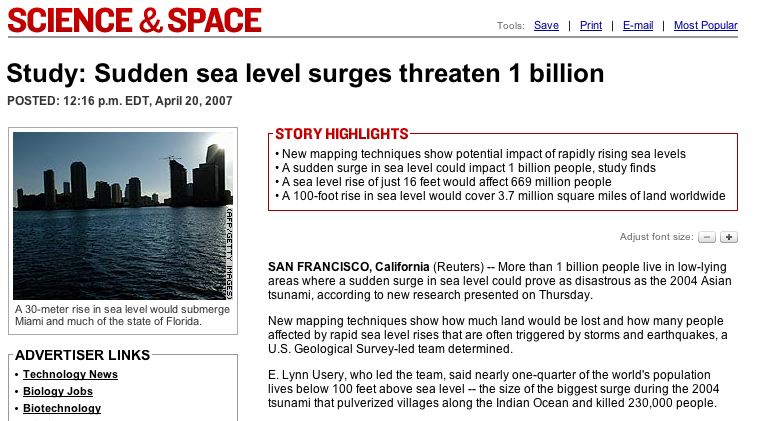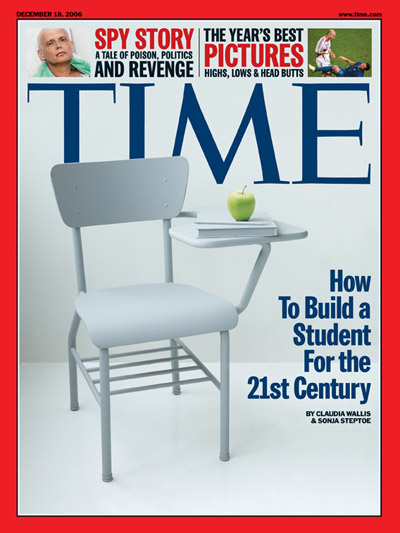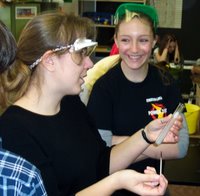Blogger Andy Carvin writes about his
recent experience in which he invited to give a presentation to a group of "educators, historians and media professionals participating in their annual summer educational institute." (There's a link to the
presentation in the post - interesting stuff!) He clicked to show a visual on YouTube and it was "flagged as inappropriate" and blocked!
The room went totally silent for a moment, then erupted in laughter. Here we were, a group of educators participating in a professional development seminar trying to discuss the role that Web 2.0 sites can play in civic education - at a presidential library, no less - and we were denied access to the information and tools we needed to have that discussion. My hosts at the library did their best to override the filters, but no one could figure out how to do it. I literally had to pantomime some of the video clips to give them a sense of what I was going to show them - and obviously, I couldn’t do any of them justice. One teacher then offered a tip to the group: if you ever get blocked, ask your students for help - they can show you a number of ways to get around the filter and access YouTube.
It's that teacher's comment that impacts me the most. S/he's right. By middle school, most kids can get around the filter. So, when no one is watching, they are accessing whatever content they want. And, all it takes is a "clear history" to outsmart the next most popular parent/teacher content-checking "trick." On the other hand, the kid who researching breast cancer or sex discrimination is blocked.
And, I've had it work the other way as well. While looking up an image of a medieval plant used for cosmetic purposes, our "filtered" Google Images pulled up a woman who no doubt had a botanically-inspired stage name. Oh yeah, and she was not even wearing a fig leaf to cover up.
In Carvin's case, a single video** was flagged for inappropriate content, but the story brings back my reoccuring fear that our district might soon chose to block YouTube. After all, they have already blocked a variety of social networking sites, including MySpace. There is certainly enough non-academic material on YouTube to warrant a filter, however, I've often used the site in the classroom to teach about topics including the
theremin,
cicadas,
electric cars, and more. It helps bring in items that are too expensive and/or difficult to bring into the classroom. The multimedia is a nice (and free) addition to plain text resources. Another benefit is the ability to quickly assemble clips from opposing viewpoints to begin a discussion on media literacy. And, honestly, sometimes it's just plain
fun.
Filtering cannot be the only answer. There is no substitute for pre-screening materials and supervision. I would never blindly search for clips in front of a classroom, nor would I allow my students to use the Internet without circulating and monitoring their usage. Another
post discusses a recent U.S. Senate Hearing , in which the committee chair speaks against relying on technologies, like filters, to protect our kids.
Rather, our efforts must rely on a multi-layered strategy – one that teaches our children about safe and responsible online behavior; one that encourages industry action to develop tools that will aid parents in their efforts to restrict inappropriate material from their children’s access; and one that relies on swift and certain action by law enforcement officials in finding and punishing those who would use the Internet to harm children.
We cannot rely on filters alone. We need to teach kids responsible, ethical use of the Internet. As a middle school teacher, I know we cannot shelter them forever, so we might as well teach them how to navigate responsibility. And, if educators are committed to this goal, it needs to become part of the curriculum. (In my new position this fall, I am excited to have the opportunity to develop such a focus.) Additionally, everything we teach kids about responsible use, media literacy, and safety is applicable in also other areas of their lives. I think the senator has the right idea.
** CORRECTION 8/10: I misunderstood. It ends up ALL YouTube videos were blocked. That's exactly what I fear.
Labels: media literacy, technology






